| کد مقاله | کد نشریه | سال انتشار | مقاله انگلیسی | نسخه تمام متن |
|---|---|---|---|---|
| 5747471 | 1618920 | 2017 | 10 صفحه PDF | دانلود رایگان |
عنوان انگلیسی مقاله ISI
Comparative toxicological effects of two antifouling biocides on the marine diatom Chaetoceros lorenzianus: Damage and post-exposure recovery
دانلود مقاله + سفارش ترجمه
دانلود مقاله ISI انگلیسی
رایگان برای ایرانیان
کلمات کلیدی
موضوعات مرتبط
علوم زیستی و بیوفناوری
علوم محیط زیست
شیمی زیست محیطی
پیش نمایش صفحه اول مقاله

چکیده انگلیسی
Antifouling biocides are commonly used in coastal electric power stations to prevent biofouling in their condenser cooling systems. However, the environmental impact of the chemical biocides is less understood than the thermal stress effects caused by the condenser effluents. In this study, Chaetoceros lorenzianus, a representative marine diatom, was used to analyse the toxicity of two antifouling biocides, chlorine and chlorine dioxide. The diatom cells were subjected to a range of concentrations of the biocides (from 0.05 to 2Â mg/L, as total residual oxidants, TRO) for contact time of 30Â min. They were analysed for viability, genotoxicity, chlorophyll a and cell density endpoints. The cells were affected at all concentrations of the biocides (0.05-2Â mg/L), showing dose-dependent decrease in viability and increase in DNA damage. The treated cells were later incubated in filtered seawater devoid of biocide to check for recovery. The cells were able to recover in terms of overall viability and DNA damage, when they had been initially treated with low concentrations of the biocides (0.5Â mg/L of Cl2 or 0.2Â mg/L of ClO2). Chlorophyll a analysis showed irreparable damage at all concentrations, while cell density showed increasing trend of reduction, if treated above 0.5Â mg/L of Cl2 and 0.2Â mg/L of ClO2. The data indicated that in C. lorenzianus, cumulative toxic effects and recovery potential of ClO2 up to 0.2Â mg/L were comparable with those of Cl2, up to 0.5Â mg/L concentration in terms of the studied endpoints. The results indicate that at the biocide levels currently being used at power stations, recovery of the organism is feasible upon return to ambient environment. Similar studies should be carried out on other planktonic and benthic organisms, which will be helpful in the formulation of future guidelines for discharge of upcoming antifouling biocides such as chlorine dioxide.
ناشر
Database: Elsevier - ScienceDirect (ساینس دایرکت)
Journal: Ecotoxicology and Environmental Safety - Volume 144, October 2017, Pages 97-106
Journal: Ecotoxicology and Environmental Safety - Volume 144, October 2017, Pages 97-106
نویسندگان
Pooja Chavan, Rajesh Kumar, Ramalingam Kirubagaran, Vayalam P. Venugopalan,